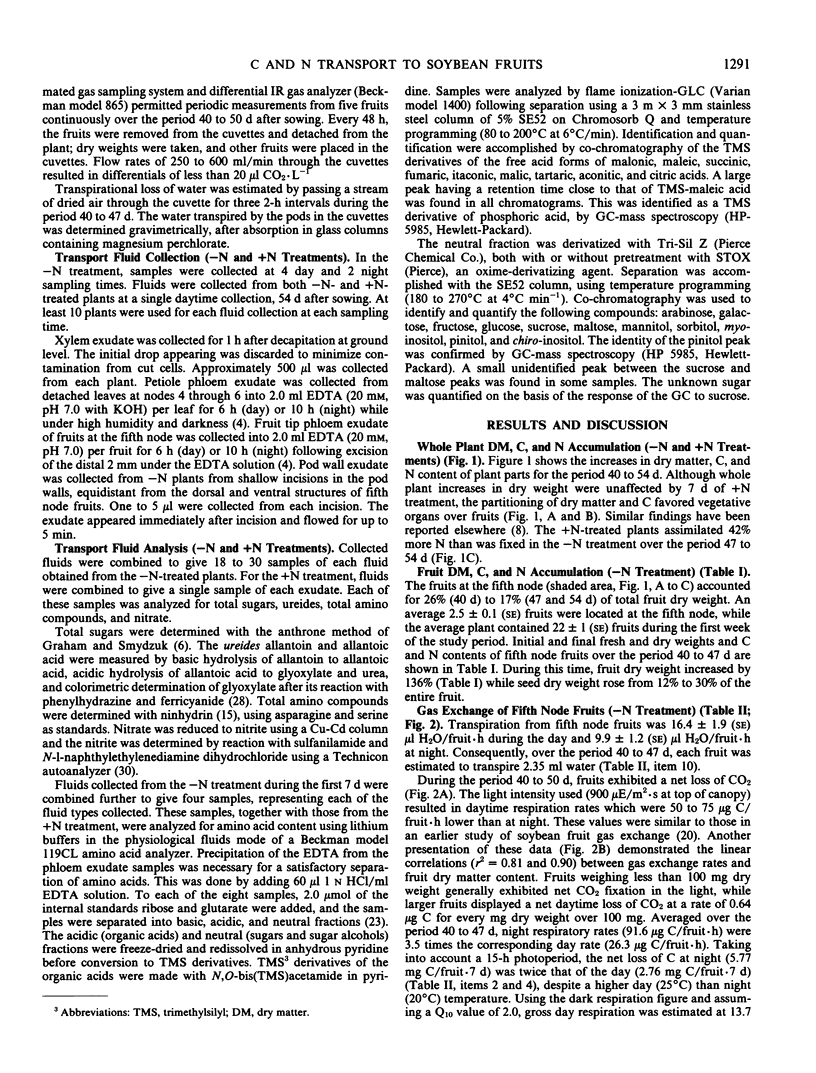Abstract
Xylem sap and phloem exudates from detached leaves and fruit tips were collected and analyzed during early pod-fill in nodulated soybeans (Glycine max (L.) Merr. cv Wilkin) grown without (−N) and with (+N) NH4NO3. Ureides were the predominant from (91%) of N transported in the xylem of −N plants, while amides (45%) and nitrate (23%) accounted for most of the N in the xylem of +N plants. Amino acids (44%) and ureides (36%) were the major N forms exported in phloem from leaves in −N plants, but amides (63%) were most important in +N plants. Based on the composition of fruit tip phloem, ureides (55% and 33%) and amides (26% and 47%) accounted for the majority of N imported by fruits of −N and +N plants, respectively.
C:N weight ratios were lowest in xylem exudate (1.37 and 1.32), highest in petiole phloem (24.5 and 26.0), and intermediate in fruit tip exudate (12.6 and 12.1) for the −N and +N treatments, respectively. The ratios were combined with data on fruit growth and respiration to construct a model of C and N transport to developing fruits. The model indicates xylem to phloem transfer provides 35% to 52% of fruit N. Results suggest the phloem entering fruits oversupplies their N requirement so that 13% of the N imported is exported from fruit in the xylem.
Full text
PDF








Selected References
These references are in PubMed. This may not be the complete list of references from this article.
- Clements H. F. MOVEMENT OF ORGANIC SOLUTES IN THE SAUSAGE TREE KIGELIA AFRICANA. Plant Physiol. 1940 Oct;15(4):689–700. doi: 10.1104/pp.15.4.689. [DOI] [PMC free article] [PubMed] [Google Scholar]
- Crafts A. S., Lorenz O. A. COMPOSITION OF FRUITS AND PHLOEM EXUDATE OF CUCURBITS. Plant Physiol. 1944 Apr;19(2):326–337. doi: 10.1104/pp.19.2.326. [DOI] [PMC free article] [PubMed] [Google Scholar]
- Eastin E. F. Total nitrogen determining for plant material containing nitrate. Anal Biochem. 1978 Apr;85(2):591–594. doi: 10.1016/0003-2697(78)90259-2. [DOI] [PubMed] [Google Scholar]
- Fellows R. J., Egli D. B., Leggett J. E. A Pod Leakage Technique for Phloem Translocation Studies in Soybean (Glycine max [L.] Merr.). Plant Physiol. 1978 Nov;62(5):812–814. doi: 10.1104/pp.62.5.812. [DOI] [PMC free article] [PubMed] [Google Scholar]
- Graham D., Smydzuk J. Use of anthrone in the quantitative determination of hexose phosphates. Anal Biochem. 1965 May;11(2):246–255. doi: 10.1016/0003-2697(65)90012-6. [DOI] [PubMed] [Google Scholar]
- King R. W., Zeevaart J. A. Enhancement of Phloem exudation from cut petioles by chelating agents. Plant Physiol. 1974 Jan;53(1):96–103. doi: 10.1104/pp.53.1.96. [DOI] [PMC free article] [PubMed] [Google Scholar]
- Layzell D. B., Pate J. S., Atkins C. A., Canvin D. T. Partitioning of carbon and nitrogen and the nutrition of root and shoot apex in a nodulated legume. Plant Physiol. 1981 Jan;67(1):30–36. doi: 10.1104/pp.67.1.30. [DOI] [PMC free article] [PubMed] [Google Scholar]
- Layzell D. B., Rainbird R. M., Atkins C. A., Pate J. S. Economy of Photosynthate Use in Nitrogen-fixing Legume Nodules: Observations on Two Contrasting Symbioses. Plant Physiol. 1979 Nov;64(5):888–891. doi: 10.1104/pp.64.5.888. [DOI] [PMC free article] [PubMed] [Google Scholar]
- McClure P. R., Israel D. W. Transport of nitrogen in the xylem of soybean plants. Plant Physiol. 1979 Sep;64(3):411–416. doi: 10.1104/pp.64.3.411. [DOI] [PMC free article] [PubMed] [Google Scholar]
- Mengel K., Haeder H. E. Effect of Potassium Supply on the Rate of Phloem Sap Exudation and the Composition of Phloem Sap of Ricinus communis. Plant Physiol. 1977 Feb;59(2):282–284. doi: 10.1104/pp.59.2.282. [DOI] [PMC free article] [PubMed] [Google Scholar]
- Moose C. A. CHEMICAL AND SPECTROSCOPIC ANALYSIS OF PHLOEM EXUDATE AND PARENCHYMA SAP FROM SEVERAL SPECIES OF PLANTS. Plant Physiol. 1938 Apr;13(2):365–380. doi: 10.1104/pp.13.2.365. [DOI] [PMC free article] [PubMed] [Google Scholar]
- Pate J. S., Layzell D. B., McNeil D. L. Modeling the transport and utilization of carbon and nitrogen in a nodulated legume. Plant Physiol. 1979 Apr;63(4):730–737. doi: 10.1104/pp.63.4.730. [DOI] [PMC free article] [PubMed] [Google Scholar]
- Pate J. S., Sharkey P. J., Atkins C. A. Nutrition of a developing legume fruit: functional economy in terms of carbon, nitrogen, water. Plant Physiol. 1977 Mar;59(3):506–510. doi: 10.1104/pp.59.3.506. [DOI] [PMC free article] [PubMed] [Google Scholar]
- Quebedeaux B., Chollet R. Growth and Development of Soybean (Glycine max [L.] Merr.) Pods: CO(2) Exchange and Enzyme Studies. Plant Physiol. 1975 Apr;55(4):745–748. doi: 10.1104/pp.55.4.745. [DOI] [PMC free article] [PubMed] [Google Scholar]
- Stumpf D. K., Burris R. H. A micromethod for the purification and quantification of organic acids of the tricarboxylic acid cycle in plant tissues. Anal Biochem. 1979 May;95(1):311–315. doi: 10.1016/0003-2697(79)90221-5. [DOI] [PubMed] [Google Scholar]
- Tully R. E., Hanson A. D. Amino Acids Translocated from Turgid and Water-stressed Barley Leaves: I. Phloem Exudation Studies. Plant Physiol. 1979 Sep;64(3):460–466. doi: 10.1104/pp.64.3.460. [DOI] [PMC free article] [PubMed] [Google Scholar]
- White M. C. Metal Complexation in Xylem Fluid : I. CHEMICAL COMPOSITION OF TOMATO AND SOYBEAN STEM EXUDATE. Plant Physiol. 1981 Feb;67(2):292–300. doi: 10.1104/pp.67.2.292. [DOI] [PMC free article] [PubMed] [Google Scholar]


